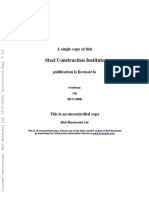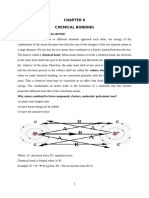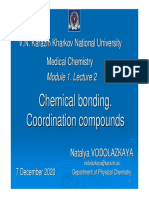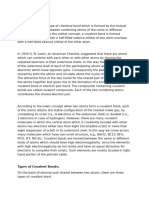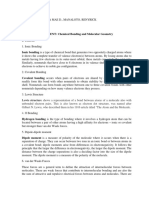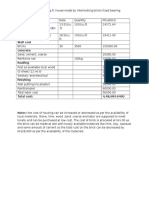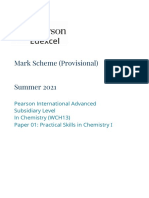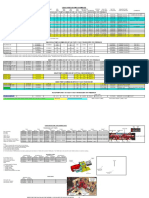Guía Quimica 3
Guía Quimica 3
Uploaded by
599d2vrgxtCopyright:
Available Formats
Guía Quimica 3
Guía Quimica 3
Uploaded by
599d2vrgxtOriginal Description:
Original Title
Copyright
Available Formats
Share this document
Did you find this document useful?
Is this content inappropriate?
Copyright:
Available Formats
Guía Quimica 3
Guía Quimica 3
Uploaded by
599d2vrgxtCopyright:
Available Formats
GUÍA QUIMICA
HYDROGEN
It is the very FIRST element in the periodic table.
MOST of the Earth’s HYDROGEN is combined with oxygen as WATER (H20).
IONIC BONDING
In an IONIC BOND, a positively charged ion is attracted to a negatively charge ion.
ION: An electrically charged element.
CATION: a positively charged ion.
ANION: a negatively charged ion.
IONIC COMPOUND: A compound that is composed entirely of ions. They have high melting point
and they tend to be brittle.
OCTET RULE
The OCTET RULE states that atoms tend to gain, lose or share electrons in order to acquire a full
set of VALENCE ELECTRONS.
VALENCE ELCTRONS: These are the OUTERMOST ELECTRONS that make the bonding in a
chemical reaction
TYPES OF BONDS
IONIC BOND: A bond between two ions with a difference of electronegativity ABOVE 0.5. In this
type of bond electrons are DONATED from one ion to the other.
COVALENT BOND: A bond between two ions with a difference of electronegativity BELLOW 0.5.
In this type of bond electrons are SHARED from one ion to the other.
LEWIS DOT DIAGRAMS
These diagrams are used to represent visually the VALANCE ELECTRONS of an ion.
STUDY THE CRISSCROSS METHOD FOR BINARY IONIC COMPOUNDS
COVALENT BONDING
A covalent bond is formed by a shared pair of electrons between two atoms.
MOLECULE: A GROUP of atoms that are UNITED by COVALENT BONDS
MOLECULAR SUBSTANCE: A SUBSTANCE that is made of MOLECULES
POLAR COVALENT BONDS: A COVALENT BOND where the there is a difference in
electronegativity no more than .5, usually between DIFFERENT ELEMENTS. This little difference
in electronegativity causes one side of the bond to be more positive than the other without
turning it into an IONIC BOND
NONPOLAR COVALENT BONDS: A COVALENT BOND usually between the same ions or those
which DON’T have a significant difference in electronegativity to turn it POLAR. Therefore,
THERE IS NO POSITIVE NOR NEGATIVE SIDE TO THE COMPUND FORMED
STUDY COVALENT BOND EXCERCISES
NAMING CHEMICAL COMPOUNDS
-Chemist name a COMPOUND according to the ATOMS and BONDS that compose it.
-For example: K (POTASSIUM), and I (IODINE), form the molecule “KI” or called “POTASSIUM
IODIDE”. Mg (MAGNESIUM), and Cl (CHLORINE), form the molecule “MgCl2” or called
“MAGNESIUM DICHLORIDE”.
-It is important to add the appropriate numeric preffix to accommodate the number of atoms
involved.
-Numeric prefixes: mono (1), di (2), tri (3), tetra (4), penta (5), Hexa (6), hepta (7), octa (8), nona
(9) , deca (10).
-For example: N (NITROGEN), and O (OXYGEN), form the molecule “NO2” or called “NITROGEN
DIOXIDE”. P (PHOSPHOROUS), and O (OXYGEN), form the molecule “P2O5” or called
“DIPHOSPHOROUS PENTAOXIDE”.
PERIODIC TABLE NEEDED FOR THE EXAMN IN ENGLISH!
You might also like
- ISSA Design & Inspection Manual 2021Document113 pagesISSA Design & Inspection Manual 2021sayed.h.hekmatNo ratings yet
- BEL Probationary Engineer Previous Papers & BEL PE Model PapersDocument6 pagesBEL Probationary Engineer Previous Papers & BEL PE Model Papersrakesh_200003No ratings yet
- Moment Connection - TablesDocument95 pagesMoment Connection - Tablescactushito100% (1)
- 4 Types of Chemical Bonds - DummiesDocument2 pages4 Types of Chemical Bonds - DummiesMarta HalimNo ratings yet
- Basic Chemistry 1Document32 pagesBasic Chemistry 1elmhycaNo ratings yet
- Covalent and Ionic Bonding MYPDocument4 pagesCovalent and Ionic Bonding MYPamourion24No ratings yet
- SGC Chemical BondingDocument22 pagesSGC Chemical Bondingcassandraolmido18No ratings yet
- GCFGCGCFGFDGDocument15 pagesGCFGCGCFGFDGZabrinaRuizNo ratings yet
- Ionic and Covalent BondsDocument5 pagesIonic and Covalent BondsFern HofileñaNo ratings yet
- Chemical BondingDocument22 pagesChemical BondingJr CarpelaNo ratings yet
- Coordinate Bonding Grade 9Document12 pagesCoordinate Bonding Grade 9Vipul GuptaNo ratings yet
- Chapter Two Chemical BondinG EDDocument77 pagesChapter Two Chemical BondinG EDnasec38602No ratings yet
- MELC 7 Chemical Bonding 1Document32 pagesMELC 7 Chemical Bonding 1A Dee YoungNo ratings yet
- Structure of MoleculesDocument11 pagesStructure of MoleculesalxsxxdNo ratings yet
- Properties of BondsDocument36 pagesProperties of BondsPaulNo ratings yet
- Hsslive-Xi-Ch-4-Slide-Chemical BondingDocument156 pagesHsslive-Xi-Ch-4-Slide-Chemical Bondingshraja2302No ratings yet
- Inorganic-Lec 4Document5 pagesInorganic-Lec 4s89844240No ratings yet
- Basic Chemistry Course Lec-3 & 4Document21 pagesBasic Chemistry Course Lec-3 & 4Ariyan Abrar SaifNo ratings yet
- Chemical Bond Notes by TouhidDocument23 pagesChemical Bond Notes by Touhidnabilnakib0077No ratings yet
- 02 Chem X Icse Summary Chemical BondingDocument10 pages02 Chem X Icse Summary Chemical BondingShreyash ThamkeNo ratings yet
- Chemical Bond 1105Document51 pagesChemical Bond 1105Abid HasanNo ratings yet
- Chapter 6Document34 pagesChapter 6gaimjohn2023No ratings yet
- Chemical Bond (2021)Document78 pagesChemical Bond (2021)KurukawaNo ratings yet
- Chemical Bonds Chemical CompoundsDocument68 pagesChemical Bonds Chemical CompoundsRalph RebugioNo ratings yet
- Chemical Bonding PptDocument46 pagesChemical Bonding PptNamann AdarshhNo ratings yet
- Lesson3 - Chemical Bonding PDFDocument6 pagesLesson3 - Chemical Bonding PDFMia ChanNo ratings yet
- l7Document27 pagesl7mohammd arif mugheriNo ratings yet
- Sch 2120 set 2Document33 pagesSch 2120 set 2stevemutisya10No ratings yet
- 02 CHEM X ICSE SUMMARY Chemical BondingDocument9 pages02 CHEM X ICSE SUMMARY Chemical BondingNatasha DalalNo ratings yet
- Chemical BondingDocument17 pagesChemical BondingBikramNo ratings yet
- Class 11 Chemistry Revision Notes Chemical Bonding and Molecular StructureDocument26 pagesClass 11 Chemistry Revision Notes Chemical Bonding and Molecular Structureshusa harshaNo ratings yet
- EnE 250 Air Quality Management and Pollution Control Lecture 03 - 2 Characterizing Air Pollution Oct 2015Document115 pagesEnE 250 Air Quality Management and Pollution Control Lecture 03 - 2 Characterizing Air Pollution Oct 2015Alexis Bryan RiveraNo ratings yet
- Module 1 Lecture 2Document31 pagesModule 1 Lecture 2Amirs AmjadNo ratings yet
- Chapter 1 Bonding and Molecular Sructure I Chemical BondingDocument5 pagesChapter 1 Bonding and Molecular Sructure I Chemical BondingJonathan SaydeNo ratings yet
- Chemical BondingDocument132 pagesChemical BondingKowser mahmud100% (1)
- Chemical Bonding and Molecular StructureDocument13 pagesChemical Bonding and Molecular StructureVishal Malik100% (1)
- Class 10 Chemistry Chapter 2 Revision NotesDocument2 pagesClass 10 Chemistry Chapter 2 Revision NotesMd TaaseenNo ratings yet
- DocumentDocument31 pagesDocumentangelica faith santosNo ratings yet
- Chem Notes CHPTR 5Document6 pagesChem Notes CHPTR 5Wan HasliraNo ratings yet
- Covalent BondDocument7 pagesCovalent BondMasood ur RehmanNo ratings yet
- Class 10th Chemistry NotesDocument4 pagesClass 10th Chemistry NotesRehan KhanNo ratings yet
- VBT MotDocument23 pagesVBT Motskyanan592No ratings yet
- Chemical BondingDocument26 pagesChemical BondingPrakash KhadkaNo ratings yet
- Chemical Bond 21Document16 pagesChemical Bond 21Thanks OdoiNo ratings yet
- Lo5 1) Chemical BondsDocument9 pagesLo5 1) Chemical BondsabdogamreNo ratings yet
- Chemical Bonds: Lecturer: Dr. Yayooo Course Title: Organic ChemistryDocument50 pagesChemical Bonds: Lecturer: Dr. Yayooo Course Title: Organic Chemistryyayooo200450% (2)
- Chapter 2, Atkins Chemical Principles The Quest For InsightDocument6 pagesChapter 2, Atkins Chemical Principles The Quest For InsightericthecmhNo ratings yet
- Chemicalbonding 130616231436 Phpapp02Document15 pagesChemicalbonding 130616231436 Phpapp02poojadimpal9No ratings yet
- Unit 4 Chemical Bonding 2021Document88 pagesUnit 4 Chemical Bonding 2021Damz RtgNo ratings yet
- Definition: What Is A Chemical Bond? Different Types of Chemical Bonds With Examples FaqsDocument33 pagesDefinition: What Is A Chemical Bond? Different Types of Chemical Bonds With Examples FaqsMedakayala Nagasravanthi 20PHD7125No ratings yet
- Chemical Bonding and Molecular StructureDocument14 pagesChemical Bonding and Molecular StructureRoshita G PillaiNo ratings yet
- Chemical Bonding and Molecular StructureDocument14 pagesChemical Bonding and Molecular StructureRoshita G Pillai100% (1)
- Chemical BondingDocument33 pagesChemical BondingMarion PootenNo ratings yet
- Chemical Bonding & Molecular Structure (Lecture Note)Document30 pagesChemical Bonding & Molecular Structure (Lecture Note)rosetom0907No ratings yet
- Chemical BondingDocument53 pagesChemical Bondingpream.s1323No ratings yet
- Ionic and Covalent BondsDocument9 pagesIonic and Covalent BondsJad SuleimanNo ratings yet
- Micro ProjrctDocument17 pagesMicro Projrctshahunikam2008No ratings yet
- Class IX Chemistry Chapter 05Document10 pagesClass IX Chemistry Chapter 05Sam FisherNo ratings yet
- Lewis Structure Shows A Representation of A Bond Between Atoms of A Molecule Also WithDocument4 pagesLewis Structure Shows A Representation of A Bond Between Atoms of A Molecule Also WithRen ManalotoNo ratings yet
- ° Polar and Non-Polar Covalent Bonds 3Document23 pages° Polar and Non-Polar Covalent Bonds 3Zayyan AliNo ratings yet
- Unit ViDocument33 pagesUnit ViIvy Marie ToyonganNo ratings yet
- A-Level Chemistry Revision: Cheeky Revision ShortcutsFrom EverandA-Level Chemistry Revision: Cheeky Revision ShortcutsRating: 4 out of 5 stars4/5 (5)
- Practice Makes Perfect in Chemistry: Chemical BondingFrom EverandPractice Makes Perfect in Chemistry: Chemical BondingRating: 5 out of 5 stars5/5 (3)
- Hot-Dip Galvanizing Vs Continuous Sheet GalvanizingDocument2 pagesHot-Dip Galvanizing Vs Continuous Sheet Galvanizingecaph244No ratings yet
- 3M Adhesive Backed Rare Earth Neodymium NdFeB Disc MagnetsDocument1 page3M Adhesive Backed Rare Earth Neodymium NdFeB Disc MagnetsSteve HsuNo ratings yet
- CostDocument1 pageCostUtsav NeupaneNo ratings yet
- Thermocouple With Flange Thermowell Tapered & Adjustable Compensation FittingDocument1 pageThermocouple With Flange Thermowell Tapered & Adjustable Compensation Fittingmohan babuNo ratings yet
- Work Method Statement For Installation and Commissioning of Cathodic Protection System For SPL Mogas Pipeline Project ShikarpurDocument8 pagesWork Method Statement For Installation and Commissioning of Cathodic Protection System For SPL Mogas Pipeline Project ShikarpurShakeel MemonNo ratings yet
- Unit No 1: Reinforced Concrete IntroductionDocument29 pagesUnit No 1: Reinforced Concrete IntroductionOladimeji Ibukun IjaodolaNo ratings yet
- Editorial: Nanostructured Optoelectronics: Materials and DevicesDocument3 pagesEditorial: Nanostructured Optoelectronics: Materials and DevicesBalaji Raja RajanNo ratings yet
- Chemistry UNIT 3 WCH13 01 MS June 21Document23 pagesChemistry UNIT 3 WCH13 01 MS June 21mNo ratings yet
- 01.physical Structures of FibresDocument11 pages01.physical Structures of FibresHadiuzzaman LeonNo ratings yet
- NDD010-MCS Type BDocument5 pagesNDD010-MCS Type BShariq KhanNo ratings yet
- Precautions of Experiment of PhysicsDocument1 pagePrecautions of Experiment of PhysicsA. Suhaimi55% (11)
- Solutions Manual To Accompany Physics 5th Edition Vol 2 9780471401940Document13 pagesSolutions Manual To Accompany Physics 5th Edition Vol 2 9780471401940Danielle Goff100% (36)
- 2022HB79036Document45 pages2022HB79036pandiyarajan NNo ratings yet
- PT Slab Bridge Deck 20 MDocument8 pagesPT Slab Bridge Deck 20 Msamirbendre1No ratings yet
- Dual Shield II 101 1.6 MMDocument2 pagesDual Shield II 101 1.6 MMadanmeneses1No ratings yet
- Method Statement For Concrete Works: The Custodian of Two Holy Mosques King Abdullah Ibn Abdul-Aziz Project KAP5-Group 4Document41 pagesMethod Statement For Concrete Works: The Custodian of Two Holy Mosques King Abdullah Ibn Abdul-Aziz Project KAP5-Group 4Domie Neil Bucag Salas100% (1)
- Cavitation in Water: A Review: Frédéric Caupin, Eric HerbertDocument18 pagesCavitation in Water: A Review: Frédéric Caupin, Eric HerbertDarko TadicNo ratings yet
- Datos WaukeshaDocument3 pagesDatos WaukeshaMariano ErdbecherNo ratings yet
- Trash Recycling Questions and Answers Harvey 1 PDFDocument4 pagesTrash Recycling Questions and Answers Harvey 1 PDFAdam DiChiaraNo ratings yet
- Waste Foundry Sand Recycling by Calcinations. Quality and Economical AvailabilityDocument10 pagesWaste Foundry Sand Recycling by Calcinations. Quality and Economical AvailabilityMario WhoeverNo ratings yet
- Solar Cell Literature ReviewDocument6 pagesSolar Cell Literature Reviewaflsktofz100% (1)
- PFI-ES-05 (Cleaning 2006) PDFDocument2 pagesPFI-ES-05 (Cleaning 2006) PDFRamesh Kumar RamisettiNo ratings yet
- DenimDocument11 pagesDenimJ.SathishNo ratings yet
- Final Structure LabDocument38 pagesFinal Structure LabNurul Syuhada0% (1)
- ITA 2012 Sir Alan Muir Wood LectureDocument10 pagesITA 2012 Sir Alan Muir Wood LectureFlaviaNo ratings yet
- Chemistry For Information Science and Electrical 6Document10 pagesChemistry For Information Science and Electrical 6sreenathsreesaNo ratings yet
- Assignment On Crysallography NotesDocument1 pageAssignment On Crysallography NotesShilpa MakeshwarNo ratings yet


